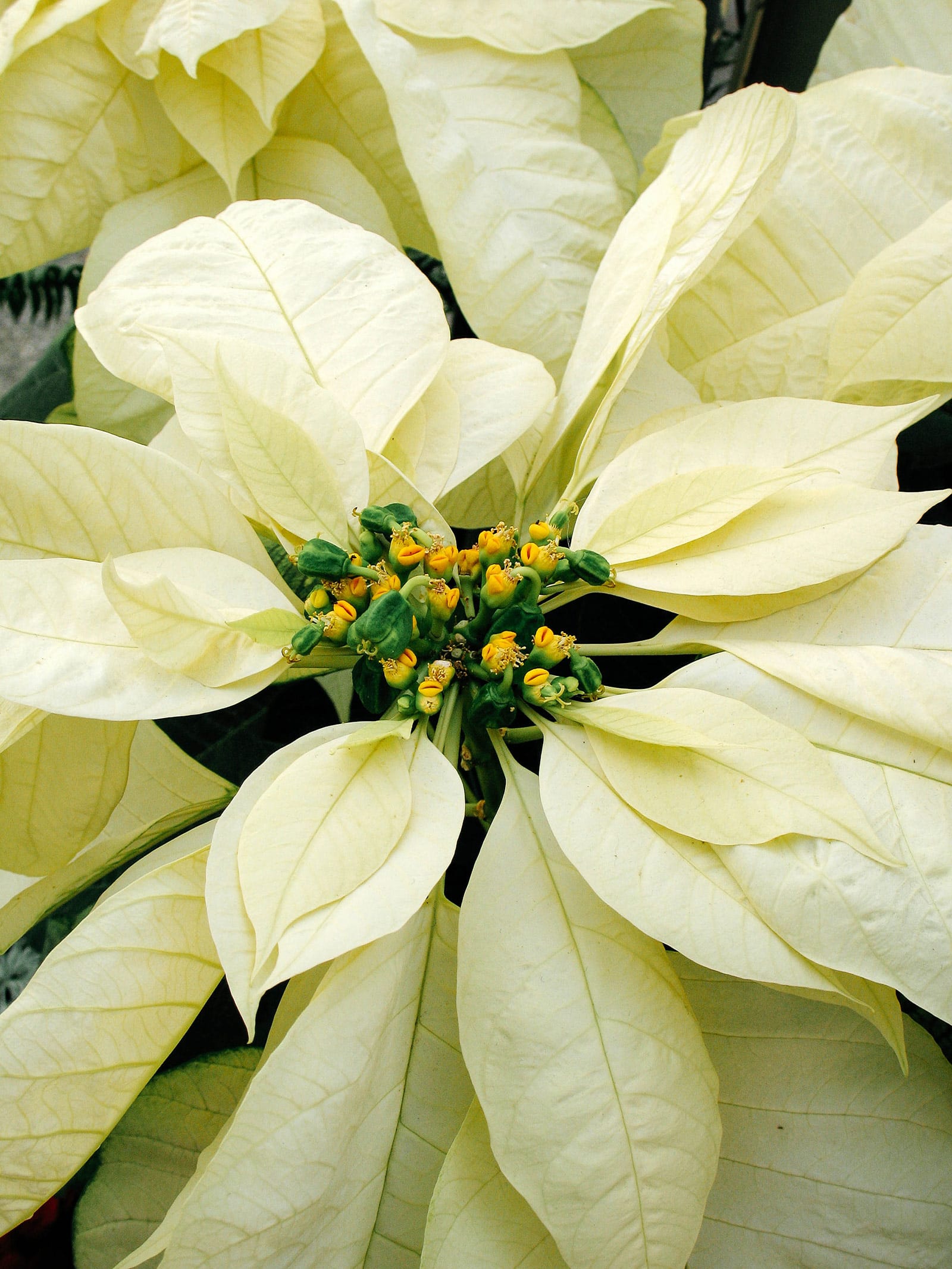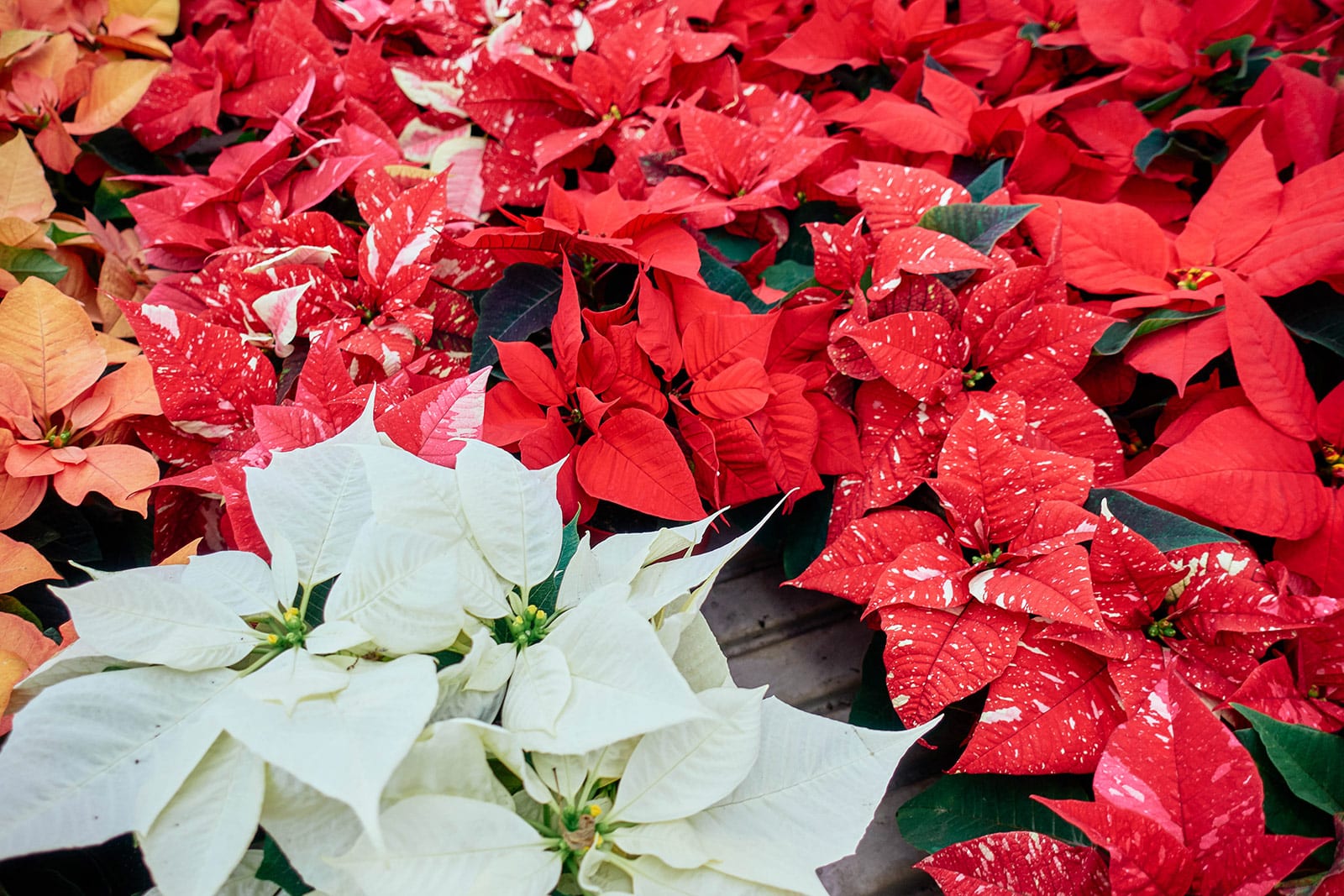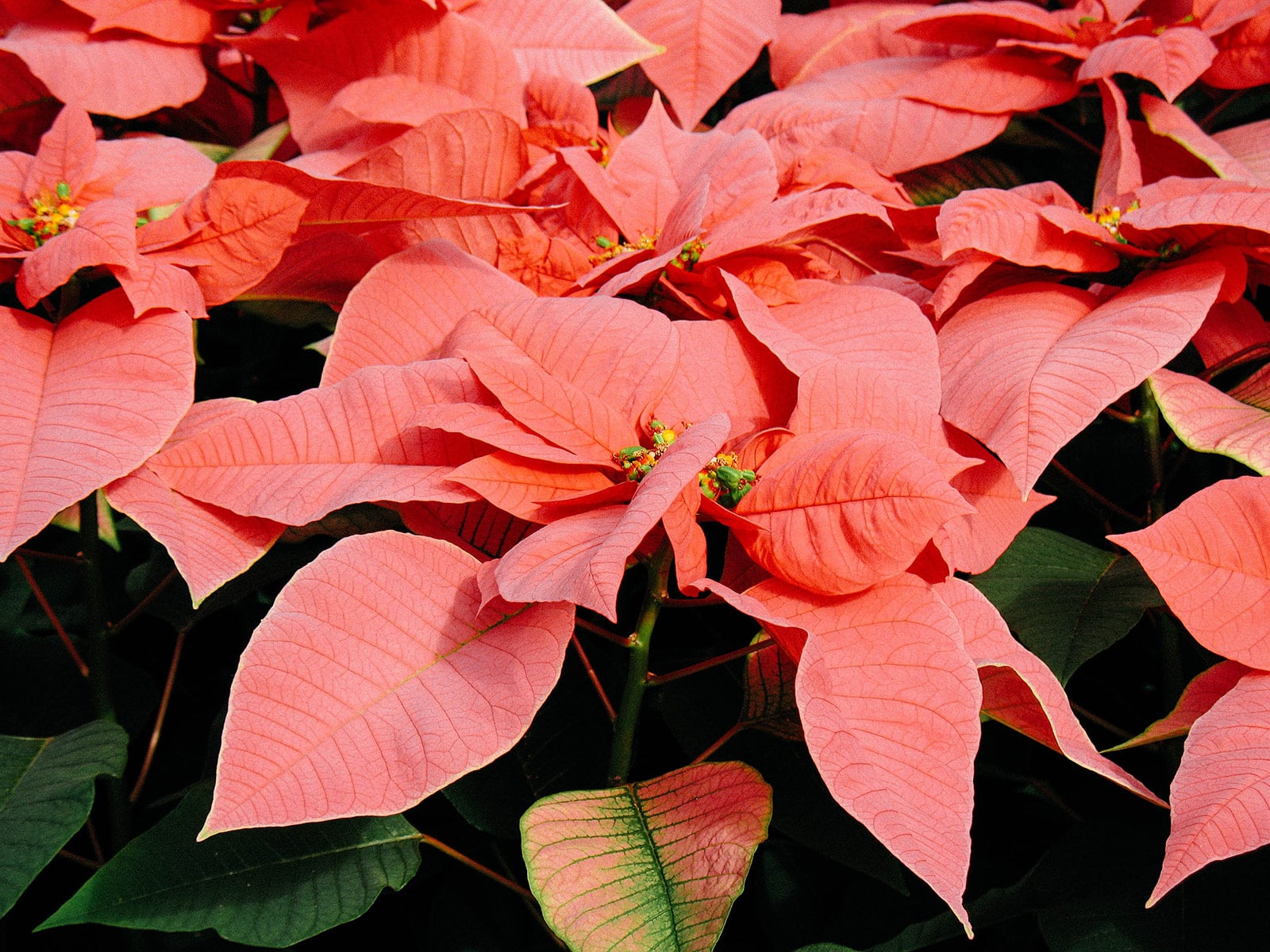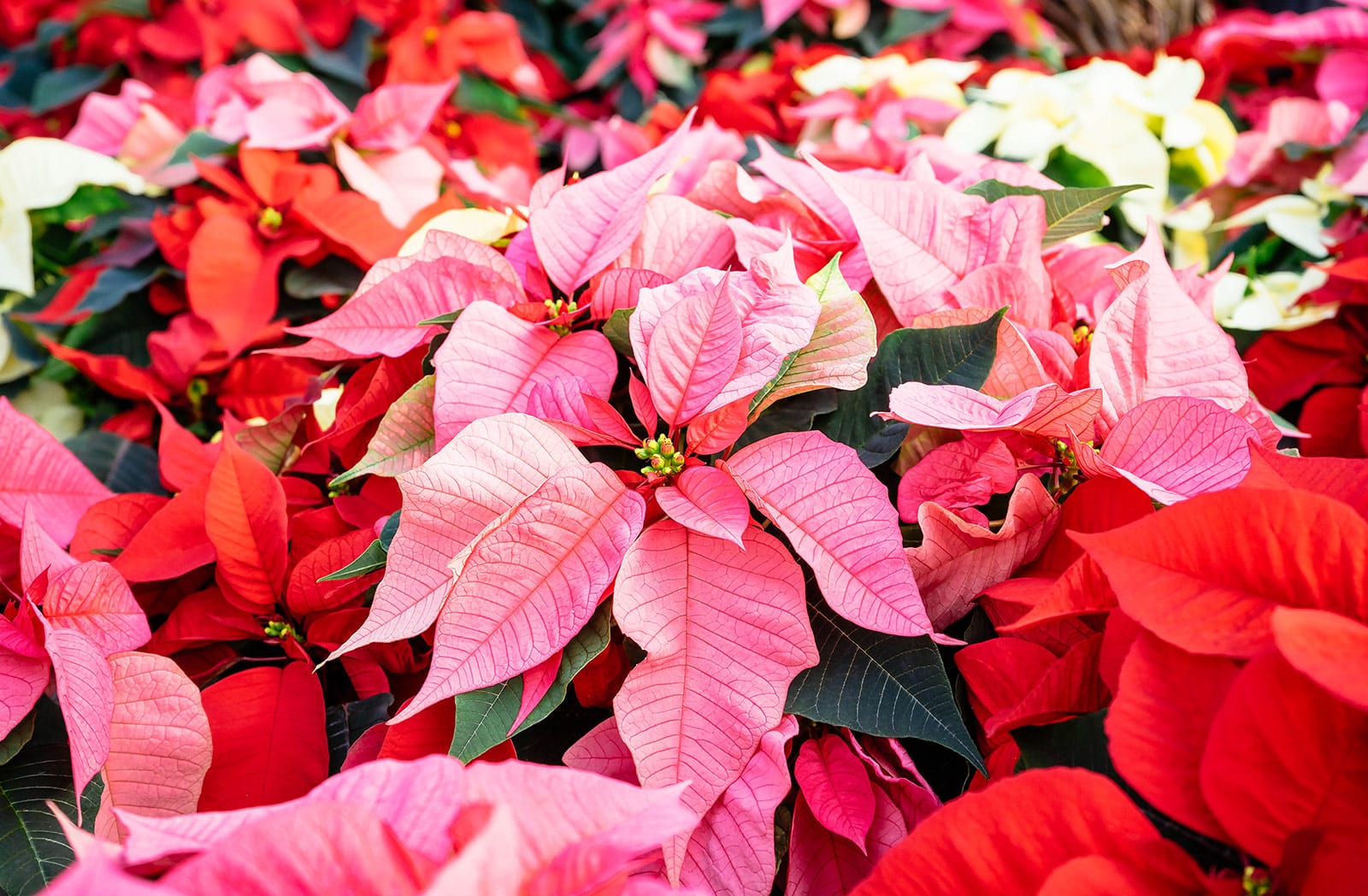Did you bring home a beautiful Poinsettia for the holidays? Not surprising! These colorful houseplants have been a popular Christmas classic since the 19th century. They bloom during winter, making them perfect for brightening up your house during the darker months.
Keep reading for everything you need to know about Poinsettias, including how to care for them after the holidays and how to make them rebloom!
Disclosure: If you shop from my article or make a purchase through one of my links, I may receive commissions on some of the products I recommend.

What is a Poinsettia?
Appearance and colors
Also known as a Christmas starflower (but not to be confused with Lysimachia borealis, a perennial herb of the primrose family that’s commonly called a starflower), the Poinsettia ranks right up there with mistletoe as a classic symbol of the holidays.
Read more: The Real (and Weird) Reason We Kiss Under the Mistletoe
“Poinsettia” is a common name for Euphorbia pulcherrima, a shrubby plant with dark green foliage. The species looks pretty unassuming for most of the year, but a real spectacle starts when the plant starts blooming during the winter months. It will begin pushing out star-shaped bracts that look like the rest of the leaves, but are brightly colored.
Naturally, these bracts are a fiery red, but nurseries have managed to selectively breed Poinsettias to produce all sorts of other colors:
- White
- Cream
- Pink
- Salmon
- Light green
- Marbled or speckled

With hundreds of cultivars out there, there truly is a Poinsettia for everyone! Some nurseries even sell blue or purple specimens, but keep in mind that those are dyed. Their flowers will likely come back white next year.
You may also find Poinsettias for sale that sport jagged foliage.
Did you know? A Poinsettia’s bracts are often confused for its flowers, but the real flowers are actually tiny and unassuming. You’ll find them in the center of the colored leaves.
Natural habitat
Euphorbia pulcherrima is naturally found in Central America, from Mexico to Guatemala. Here, wild plants are much lankier-looking than their domestic counterparts, but they can reach huge sizes and look like colorful trees. The Poinsettia is also an invasive species in various other countries in South America, Africa, Europe, and Asia.
The species occurs in tropical to dry forests at moderate elevations. These habitats are characterized by their long dry seasons.
Sadly, Poinsettias aren’t as common in their natural range as they used to be. The species is still listed as Least Concern on the IUCN Red List, but the database does note that its habitat is in continuous decline. Populations are highly fragmented, with low genetic diversity and the risk of the gene pool being muddled with domestic plants.
History and cultural significance
Poinsettia plants have a long, long history behind them. In Mexico, before colonization, the species was used by the Aztec peoples for various purposes: in traditional medicine, for decoration during the winter blooming period, to produce dye, and more.
Once the Catholic Spanish conquerors arrived in Central America, they adopted the species for use in their existing Christmas rituals. That’s why Poinsettias are still called “flor de Nochebuena” (Christmas Eve flower) in this region. Interestingly, in Spain, the species is instead called “flor de Pascua”, which means Easter flower.
The story of the plant’s arrival in the US is that it was brought over by J.R. Poinsett, the first US minister to Mexico, in the 1820s. Although there isn’t actually much evidence to corroborate this, the name stuck! From this point onward, nurseries began working on the wide variety of Poinsettias we know today.
Nowadays, the Poinsettia has been noted by some studies to be the world’s most economically significant potted plant. A partial monopoly on the US and worldwide market is held by the Ecke family, which began their Poinsettia cultivation operations in the early 20th century. The plant is very widely cultivated in Central America for export around the world.

Poinsettia buying guide
If you’ve brought home Poinsettias for the holidays before, you’ll know these aren’t the easiest plants to keep alive (which is why some people opt for other types of holiday houseplants). Poinsettias often arrive at your home already stressed from shipping (or from being manhandled at the store), exposed to cold and either underwatered or overwatered.
This means that in many cases, you’re not exactly off to a good start. The species is also prone to leaf drop.
To improve the chances of your Poinsettia thriving during (and after) the holidays, look for these telltale signs of a healthy plant:
- Lush, erect foliage
- No leaf drop or browning/yellowing leaves
- Soil is neither dry nor waterlogged
- Flowers are still closed
- Not placed close to the doors in the shop (they don’t like the cold and draft)
- Planter has drainage holes
Be sure not to expose your plant to cold, especially frost, on your way home. Some garden centers and plant shops will give you the option to wrap your houseplants in bubble wrap or paper for the trip to the car. However, even just a paper bag can help offer some protection!

Poinsettia care during the holidays
So how do you make sure your beautiful new Poinsettia at least makes it through the holidays?
I’ll give you a few of my tried-and-true tips here:
- If your Poinsettia was packaged in a plastic plant sleeve, take it off as soon as you get home so your plant is exposed to light and air.
- Remove the foil wrapping that may be around the pot, as it impedes drainage and can cause your new Poinsettia to drown.
- Place your plant in a bright location by a window. You can move it to the Christmas table whenever you want to display it, but the rest of the time, it likes a nice and well-lit spot.
- Keep Poinsettias away from sources of heat or cold. It won’t like to be by the heater or fireplace, nor close to drafty windows.
- Speaking of temperature, Poinsettias like it warm (but not hot) during the day and slightly cooler (around 60°F) at night. The warmer your house, the faster your Poinsettia flowers will open up—meaning a shorter bloom time.
- Keep the soil lightly moist using tepid water, never allowing the plant to stand in water for extended periods of time.
For those who want to enjoy their plant a little longer, next let’s dive into how to care for this species year-round and how to get it to rebloom next year.

Poinsettia care after the holidays
If your Poinsettia is still going strong after New Year, good job! Many people throw theirs out at this point, as it will go dormant and drop (almost) all of its foliage. Not exactly the most decorative thing to look at, I’ll admit that.
Still, there is no reason not to give keeping your Poinsettia alive year-round a shot. These aren’t the easiest houseplants, but I’ve seen some folks have success in reusing theirs for the holiday table year after year. Also, even if yours doesn’t make it, you can just try again next year.
Here’s how you do it:
The rest of winter
After the New Year, begin letting the soil go about halfway dry before watering again. In its natural habitat, things would be heading into dry season now. Poinsettias would go dormant, so you want to achieve something similar in the home.
Many sources recommend cutting the plant back to within a few inches from the soil in March or April, when all the colorful bracts and leaves have gone, but this isn’t a must.
Springtime
Hello Poinsettia! Your plant should begin to come back to life around April or May. You can opt to repot it at this point if necessary, giving it some more space and replacing the low-quality soil they’re often sold in. A general houseplant potting mix is perfectly suitable here.
Recommended potting soils for Poinsettias:
After repotting, place your Poinsettia in a nice and sunny location, or even outdoors once things have warmed up to 50°F or up. Keep the soil lightly moist, watering when the first few inches have dried out.
Summertime
Your Poinsettia can stay in its sunny spot and will hopefully be growing well at this point. Consider using a diluted liquid houseplant fertilizer every two weeks or so to give it an extra boost.
Recommended fertilizers for Poinsettias:
- Houseplant Resource Center Liquid Fertilizer for Houseplants
- Instant Biologics Instant Plant Food (Fizzing Nutrient Tablets)
- Maxsea All-Purpose Seaweed Plant Food
You can also pinch off some of the stems if you’d like a bushier look on your plant, although doing so is not a must. This practice encourages branching in plants.
Fall: making a Poinsettia rebloom
If you were growing your Poinsettia outdoors, in many climates, it’s time to bring it back in around September. Put it in a sunny window for now. You can continue to water as usual, but it’s time to start tapering off the fertilizer schedule.
If you want to see the plant bloom and color up well for the upcoming holiday season, you’ll have to start giving it some help around October.
The thing is—like many winter-blooming houseplants, including Cyclamen, amaryllis, and the aptly named Christmas (or Thanksgiving) cactus—this species knows it’s time to start producing flowers when the days begin to shorten in fall.
Related: 3 Secrets to Getting Christmas Cactus to Bloom More Than Once a Year
In our homes, we keep the lights on until late, which can confuse the plant and mess with its blooms.
So, to make a Poinsettia rebloom, you’ll want to provide total darkness whenever it’s dark outdoors. At dusk, you can pop it in a closet or place a paper bag over it. When you get up in the morning, place it back in its usual spot.
Tip: If you live in a warm climate, you may be able to keep a Poinsettia outdoors year-round and only bring it in for the holidays. This is a convenient option, because you can skip the whole “placing the plant in the closet” process. Nature takes care of that for you as the days shorten in fall.
Keep this up for up to 10 weeks or until your Poinsettia has colored up nicely and produced flower buds. At this point, it’s ready to return to normality, aside from spending some time sprucing up your holiday table of course!

Common questions about caring for Poinsettias
How long do Poinsettias last?
If properly cared for, a potted Poinsettia typically lasts two to three months indoors. However, Poinsettias are tender perennials that can live year-round as a houseplant, or outdoors as a container plant in USDA zones 10 to 11, or sometimes in zone 9 with frost protection.
Can Poinsettias live outside in the winter?
Unless you live in USDA Zones 10 to 11, probably not. Even there, you’ll have to place yours in a sheltered position, because they just tend to start to have a hard time below 50°F. Poinsettias are prone to frost damage in Zone 9 and below, and are best overwintered indoors.
Is a Poinsettia toxic to cats and dogs?
Good question! Poinsettias are often noted as being highly toxic and even deadly to pets. The good news? It’s a myth! According to Poison Control, it’s true that consumption can lead to mild symptoms like irritation, diarrhea, and vomiting, but that’s the case with most houseplants.
If your furry friend takes a bite, just keep an eye on it and offer plenty of water just in case.
More holiday plants you might like:
- Locals’ Secret: Where to Cut Your Own Christmas Tree in Oregon’s National Forests
- The Best Way to Care for a Potted Christmas Tree So You Can Plant It Afterward
- 7 Proven Tips and Tricks to Make a Christmas Tree Last Longer
- 10 Clever Ideas For Repurposing an Old Christmas Tree
Sources:
https://powo.science.kew.org/taxon/urn:lsid:ipni.org:names:30176564-2
Evens, Z. N., & Stellpflug, S. J. (2012). Holiday plants with toxic misconceptions. Western Journal of Emergency Medicine, 13(6), 538.
Taylor, J. M., Lopez, R. G., Currey, C. J., & Janick, J. (2011). The poinsettia: History and transformation. Chronica Horticulturae, 51(3), 23-28.
Trejo, L., Feria Arroyo, T. P., Olsen, K. M., Eguiarte, L. E., Arroyo, B., Gruhn, J. A., & Olson, M. E. (2012). Poinsettia’s wild ancestor in the Mexican dry tropics: historical, genetic, and environmental evidence. American Journal of Botany, 99(7), 1146-1157.
View the Web Story on poinsettia plant care.
















Their colourful bracts are always attractive and the most lovely holiday plants inside the house. Yes, you can easily grow white poinsettias inside your home. How to take care of the white poinsettias? You can plant them in a small potting mix and give them the right sunlight.
One needs to follow simple steps like collecting the roots of the winter poinsettias from a garden/ ne seedlings. Then gradually give it fertilizer, water, and sun. You can finally see the bloom of your potting winter poinsettias.
How to take care of winter rose poinsettia? You must check the roots even if your plant bloom is okay. Few brown roots determine that your winter poinsettias are pretty good but the brow/ decaying roots should not be more than 50%.
So, from the garden to your indoor corner, winter poinsettias are ready to bloom. These poinsettias bloom is a gift to you if you care for the plants.
What are the diseases of winter poinsettia?
When you think of how to take care of the winter rose poinsettias, you must count on their potential diseases. The most common diseases of winter poinsettias are the following according to The Pennsylvania State University Extension:
Falling leaves: It happens due to improper setup. For example-less light, low water, and root rotting. If you have this problem in the garden bed then maintain a space between your winter poinsettias plants in a moist soil bed.
Scab: These are yellow colour spots in the vein of the green leaves. It happens due to the Sphaceloma poinsettia fungus. So, avoid overhead watering, and support the plant with less humidity.
Powdery Mildew: It’s a common problem for all plants. The leaves turn yellow and the roots get the whiter snow-like disease. Oidium fungus is responsible for powdery mildew. So, apply fungicides to protect your winter poinsettias from powdery mildew. Also, check the cuttings to avoid the most disease when you replant.
Flower blight: Usually the brown spots on the flowers, stem and leaves. Botrytis cinerea is the causing pathogen for brown blights. Well, space between the plants, and air movement can save your winter poinsettias from brown blights.
So, these are the thriving diseases you can face on the way to how to take care of the winter poinsettias. But if you abide by the rules to grow it then the chances of the diseases are quite less.